Himachal Pradesh
state in northern India
Himachal Pradesh (Punjabi: ਹਿਮਾਚਲ ਪ੍ਰਦੇਸ਼) is a state in north India, and offers much for those looking to experience the Himalayas. While it does not claim the highest peaks in the range, there is plenty to do aside from mountaineering. Its name literally means "Abode of Snow".
.svg.png.webp)
Districts
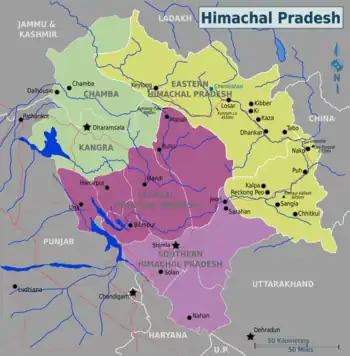
| Central Himachal Pradesh (Bilaspur, Hamirpur, Kullu, Mandi, Una) |
| Eastern Himachal Pradesh (Kinnaur, Lahaul and Spiti) |
| Northern Himachal Pradesh (Chamba, Kangra) |
| Southern Himachal Pradesh (Shimla, Sirmaur, Solan) |
Cities
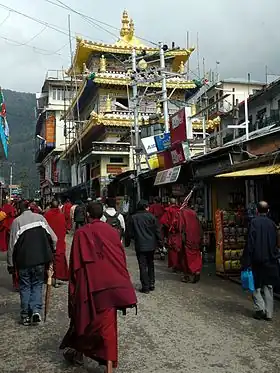
Here are nine of the most notable cities:
- 🌍 Dharamsala — the winter capital of Himachal, it is also the home of the Dalai Lama and India's largest Tibetan community and a major Buddhist centre
- 🌍 Jogindernagar — popularly known as the City of Powerhouses, the town has resorts and tourist attractions
Other destinations
- 🌍 Bharmour — the ancient capital of Chamba district, and is known for its scenic beauty and ancient temples
- 🌍 Chandrataal Lake — a beautiful high altitude lake in Spiti
- 🌍 Great Himalayan National Park —
 UNESCO World Heritage Site home to many species of wildlife
UNESCO World Heritage Site home to many species of wildlife
- 🌍NOT EXISTING LISTING IMAGE Kunjum Pass (Rohtang Pass) — on the way from Keylong to Kaza, it remains closed for nine months due to heavy snowfall
- 🌍 Masroor Rock Cut Temples - Sometimes in the 8th or 9th century - but most likely in the second half of the 8th century - one of the characteristic sandstone ridges in Kangri valley was reshaped in a miraculous way.
- 🌍 Parvati Valley — a lush green valley offering numerous treks of different grades
- 🌍 Pin Valley National Park — located in the Spiti Valley (Lahaul and Spiti), several endangered animals including the Siberian Ibex and Snow Leopard can be found in this snow-covered area
- 🌍 Tashijong — a small Tibetan settlement with a lay community of about 400 people and a Drukpa Kagyu monastery (established by the 8th Khamtrul Rinpoche) with about 140 monks.
Understand
Talk
Hindi, Pahari, Punjabi and English are the main languages found in the state. Pahari is a dialect more closely related to the Dogri language in lower Himachal. In upper Himachal languages of Tibetan origin are used in daily conversation. Every district has its own dialect, e.g. Bilaspuri Mandyali.
Get in
By plane
Shimla, Kullu (for Manali) and Kangra or Pathankot (for Dharamsala) have small airports, with services largely limited to Delhi. Flights are frequently cancelled or delayed by adverse weather. In addition, the airport in Pathankot (Punjab) can be a convenient connection for Dharamsal] and Dalhousie. If you are on a tight budget you might want to skip this option as it is way more costly than other modes of transportation. Airfare on this route is one of the highest in the world for a given unit distance. The airport for Shimla is at Jubbal Hatti, which is around 40 km away from the main Shimla City.
By train
While there are few railways within Himachal Pradesh, it is an effective way to get to within a short distance of the state. Chandigarh is well-serviced and has bus connections to Manali and Shimla, and Pathankot is a good choice if heading to Dharamsala. Due to transfer time, it would likely be slower to reach these destinations by a combination of train and bus, but it would be more comfortable.
By bus
Bus is the cheapest and only practical means of getting to many points in Himachal. All cities of interest have direct services from Delhi. There are three different entry routes to Himachal if you are coming from Delhi.
- Delhi-Chandigarh-Shimla-Kaza route.
- Delhi-Chandigarh-Bilaspur-Mandi-Manali-Keylong-Leh
- Delhi-Chandigarh-Kangra-Dharamsala or Delhi-Chandigarh-Kangra-Chamba
All three routes are interconnected within Himachal. There are Volvo buses operated by Himachal State Transport Corporation on these routes.
Get around
You need an inner line permit to visit some parts of Eastern Himachal Pradesh.
By bus
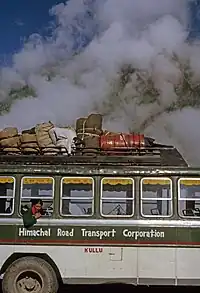
Travel by bus can be done throughout for very little (15-hour bus rides are rarely more than a few hundred rupees). Public buses, though uncomfortable, are a great way to meet people. Though be careful, as riding an Indian bus is already a hair-raising experience, and riding an Indian bus on steep mountain roads is even more intimidating!
By train
Given the difficult geographical position of the state, there is very little penetration of railways. Railways give access to peripheral districts and the capital, Shimla. Nevertheless, it is an amazing experience going from Kalka to Shimla. The Kalka-Shimla railway track is a UNESCO world heritage site. Few points in Himachal are easily accessible by train, but there are narrow-gauge railways from Pathankot (Punjab) to Kangra and Kalka (Haryana) to Shimla. This will take you through beautiful rural Himalayan regions. The ride beyond Kangra is amazing. You ride along the Dhauladhar Range of the Himalayas via Palampur and Baijnath to Joginder Nagar. The region is crisscrossed by rivers and streams.
By motorcycle
Enfield motorcycles can be rented here for less than 5 dollars a day, with no verification of a motorcycle license. Note that the area may not be the best place to learn how to ride.
See
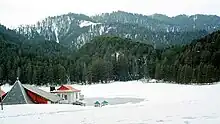
- Dalhousie is a world-famous hill station, located in the western part of Himachal Pradesh. Dalhousie is basically built on five different hills called Balun, Tehra, Kathlog, Patreyn and Bakrota, and covers an area of 14 sq. km. Dalhousie is named after one of the British Governor Generals, Lord Dalhousie. Dalhousie has many beautiful churches and charming colonial architecture.
- Kullu Valley is very well known as Valley of Gods. It is situated on the Beas River bank in the lower reaches of the Himalayas. Rudyard Kipling wrote: "Surely the Gods live here; this is no place for men". Kullu is very well known for its ancient temples, festivals and apple orchards. This place is also famous for its handicraft work and woollen work of puhla, shawls, patoos, caps and namdas. The best time to visit Kullu is during Dusshera in the month of October.
- The Lahaul Valley is green compared to the Spiti Valley. It is covered with snow for most of the year. Roads are closed from late October to early May. Its main attractions are Patten Valley and Sri Trilokinath Temple, as well as lots of monasteries.
- Spiti Valley is also known as the Little Tibet due to its vegetation, terrain and climate which are similar to Tibet. Spiti also means Middle Country.
Do
- Kangra Valley Railway – Take a scenic and slow narrow-gauge train trip between Jogindernagar, Palampur, Kangra and Pathankot
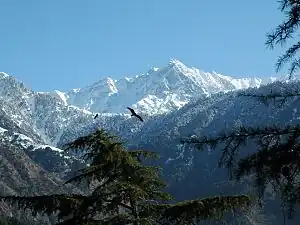
Trekking opportunities are plentiful, here are a few:
- Baralacha-Chandratal Trek – It starts from Manali, ends at Chandratal Lake ("Moon" Lake)
- Bhabha Pass Trek – It is known for lush green flower-strewn meadows, and picturesque and dense forests. The path for the Bhaba Pass trek passes through a mixed forest of conifers as well as crop fields of Mastrang.
- Bir Bhangal Trek – Bir Bhangal Trek is only for experienced trekkers who have the experience of solid hiking and camping. This is one of the most challenging trekking trails which starts from the Kullu valley.
- Darcha Lamayuru Trek – This is one of the most popular treks in Himachal Pradesh, and one of the most traversing treks, passing through the Zanskar
- Darcha Padum Trek – From Darcha village located in Lahaul and Spiti district on the Bhaga River to Padum in Zanskar Region, Ladakh via Shingo La (pass)
- Deo Tibba Expedition – Trek to beautiful Mt. Deo Tibba peak in the Manali valley
- Friendship Peak Expedition – Trek to one of the majestic mountains; Friendship Peak, in the beautiful valley of Kullu
- Hampta Pass – One of the most famous trekking trails from the Manali region in the Kullu Valley ending in Lahaul and the Chandra Valley
- Indrahar Pass – A mountain pass in the Dhauladhar range of the Himalayas that forms the border between Kangra and Chamba districts.
- Lamkhaga pass trek – A crossover from Chitkul, Kinnaur to Harsil, Uttarakhand.
Trekking routes in Himachal
- Bharmaur Kugti Udaipur Manali trek
- Chander Trail in Kullu Valley
- Dharamsala Chhota Bhangal over sari Pass Kullu
- Hamirpur Deotsidh Sri Naina Devi Trek
- Hamta Trek
- Kinner Kailash Parikrama
- Maidi to Nadaun
- Malana History Trek
- Manali Hamya Herbal Trek
- Morchella trek
- Wild Trek in Kullu Valley
Learn
- Buddhism. Classes for the study of Buddhism are taught in Dharamsala and Bir.
- Yoga. There are several places to study yoga in Dharamsala.
Eat
HP food is often very simple but nutritious, including daal, rice, roti, vegetables, paneer, curds and pickles in the Punjabi-influenced Pahari regions. Further north, Tibetan influence is stronger and barley is the main staple grain. Some of the specialities of Himachal include Manee', Madira, Pateer, Chouck, Bhagjery and chutney of Til.
Drink
In the Tibetan-influenced regions, chhang (fermented rice wine) is common.
Sleep
There are plenty of hotels and restaurants in and around District HQ as well as main tourist places. There are rest houses of HP PWD at places where it is hard to find hotels.